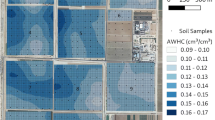Abstract
A cotton crop coefficient was modified to account for the contribution of shallow groundwater to crop water use. The data used in the modification were developed using weighing column lysimeters. The percentage groundwater contribution to crop water use, expressed as a function of growing degree days for several salinities and two water table depths, was used in the regression analysis. Use of the modified coefficient was demonstrated by scheduling a subsurface drip irrigation system installed in an area with shallow saline groundwater. Use of the modified crop coefficient resulted in 25% of the cotton water requirement being extracted from shallow groundwater with a salinity of 5 dS m-1 without any adverse effects on vegetative plant growth and yield. Groundwater depth dropped from 1.2 to 2.2 m during the growing season.
Similar content being viewed by others
References
Ayars JE, Schoneman RA (1986) Use of saline water from a shallow water table by cotton. Trans ASAE29:1674–1678
Benz LC, Doering EJ, Reichman GA (1987) Water table management saves water and energy. Trans ASAE 24:995–1001
Davis KR (1983) Trickle irrigation of cotton in California, In: Proc Western Cotton Prod, Conf. Las Cruces, NM, pp 34–38
Grimes DW, Henderson DW (1984) Developing the resource potential of a shallow groundwater. Calif Water Resources Center Bulletin No. 188 August
Grimes DW, Yamada H (1982) Relations of cotton growth and yield to minimum leaf water potential. Crop Science 22: 134
Grismer ME, Gates TK, Hanson BR (1988) Irrigation and drainage strategies in salinity problem areas. Calif Agric 23–24
Hanson BR (1987) A systems approach to drainage reduction. Calif Agric Sept–Oct: 19–24
Higgins GM, Dielman PJ, Abernethy CL (1987) Trend in irrigation development; their implications for hydrologists and water resource engineers. J Hydr Res 25:393–406
Howell TA, Hatfield JL, Rhoades JD, Meron M (1984a) Response of cotton water stress indicators to soil salinity. Irrig Sci 5:25–36
Howell TA, Hatfield JL, Yamada H, Davis KR (1984b) Evaluation of cotton canopy temperature to detect crop water stress. Trans ASAE27:84–88
Hutmacher RB, Ayars JE (1991) Managing shallow groundwater in arid irrigated areas. Paper No. 912119, ASAE International Meeting, 17 pp
Idso SB, Reginato RJ, Farah SM (1985) Soil and atmosphere-induced plant water stress in cotton as inferred from foliage temperature. Water Res Res, 28: 1143
Jensen ME (1972) Programming irrigation for greater efficiency. In: Hillel D (ed) Optimizing the soil physical environment toward greater crop yields. Academic Press, New York, pp 133–161
Kite SW, Hanson BR (1984) Irrigation scheduling under saline high water tables. Calif Agric 38: 12–14
Kruse EG, Young DA, Champion DF (1985) Effects of saline water table on corn irrigation. In: Keyes CG and Ward TJ (eds) Development and management aspects of irrigation and drainage systems. ASCE Specialty Conference, New York, pp 444–453
Maas EV, Hoffman GJ (1977) Crop salt tolerance-current assessment. Irrig Drain Div, ASCE 103:115–134
Mapel CL, Sammis TW, Lansford RR (1985) Estimating crop water production functions based on transpiration and crop growth curves through modeling. Partial Completion Report Project No. WRRI 1-3-45669, New Mexico Water Resources Institute. 38 pp
Namken LN, Weigand CL, Brown RO (1969) Water use by cotton from low and moderately saline static water tables. Agron J61: 305–310
Nielsen DR, Biggar JW, Erh KT (1973) Spatial variability of field measured soil-water properties. Hilgardia 42:215–259
Phene CJ, DeTar WR, Clark DA (1992) Real-Time irrigation scheduling with an automated pan evaporation system. Appl Engin Agric 8:787–793
Rhoades JD (1974) Drainage for salinity control. In: van Schilfgaarde J (ed) Drainage for agriculture, Agronomy No. 17. Amer Soc Agron, Madison, WI, pp 433–461
Rhoades JD, Loveday J (1990) Salinity in irrigated agriculture. In: Stewart BA, Nielsen DR (eds) Irrigation of agricultural crops, Agronomy No. 30. Amer Soc Agron, Madison, WI, pp 1089–1142
Robbins CW, Williardson LS (1980) An instrumented lysimeter system for monitoring salt and water movement. Trans ASAE 23: 106–111
San Joaquin Valley Drainage Program (1990) The problem. In: U.S. Department of Interior and California Resources Agency (ed) A Management Plan for Agricultural Subsurface Drainage and Related Problems on the westside San Joaquin Valley. Calif Dept of Water Resources, Sacramento, CA, p 183
Wallender WW, Grimes DW, Henderson DW, Stromberg LK (1979) Estimating the contribution of a perched water table to the seasonal evapotranspiration of cotton. Agron J 71:1056–1060
Westcot DW (1988) Reuse and disposal of higher salinity subsurface drainage water A review. Agric Water Management 14 (1–4): 483–511
Wright JL (1982) New evapotranspiration crop coefficients. Irrigation and Drainage Division, ASCE 108 IR2:57–74
Author information
Authors and Affiliations
Rights and permissions
About this article
Cite this article
Ayars, J.E., Hutmacher, R.B. Crop coefficients for irrigating cotton in the presence of groundwater. Irrig Sci 15, 45–52 (1994). https://doi.org/10.1007/BF00187794
Received:
Issue Date:
DOI: https://doi.org/10.1007/BF00187794




